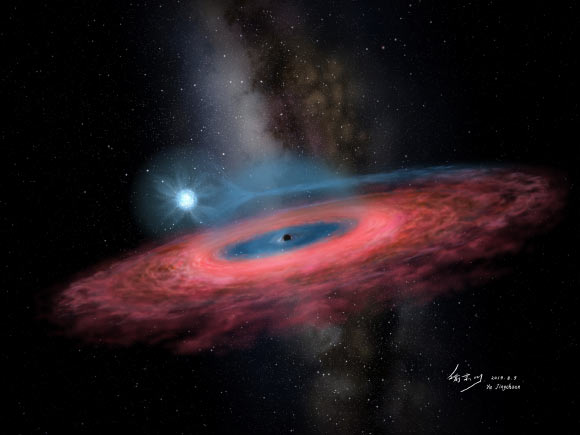Astronomers Find ‘Impossible’ Stellar Black Hole in Milky Way | Astronomy – Sci-News.com
An international team of astronomers has discovered an exceptionally massive black hole of stellar origin with a mass 68 times that of the Sun.
“Black holes of such mass should not even exist in our Milky Way Galaxy, according to most of the current models of stellar evolution,” said Dr. Jifeng Liu, an astronomer at the National Astronomical Observatory of China, the Chinese Academy of Sciences.
“We thought that very massive stars with the chemical composition typical of our Galaxy must shed most of their gas in powerful stellar winds, as they approach the end of their life. Therefore, they should not leave behind such a massive remnant.”
“The newly-discovered black hole is twice as massive as what we thought possible. Now theorists will have to take up the challenge of explaining its formation.”
“This black hole is far more massive than typical black holes that we routinely find in the Milky Way, whose masses distribute between 5 and 15 solar masses,” added Dr. Jorge Casares, a researcher in the Instituto de Astrofísica de Canarias and the Universidad de La Laguna.
The newfound black hole is part of LB-1, a star-black-hole binary system located some 13,800 light-years away in the constellation of Gemini.
“LB-1 is located at coordinates 188.23526° (Galactic longitude), +02.05089° (Galactic latitude),” the scientists said.
The black hole’s companion is a subgiant B-type star 8.2 times heavier and 9 times larger than the Sun.
The star is only 35 million years old, and it orbits the black hole once every 78.9 days.
“The LIGO/Virgo experiments revealed black holes with masses of several tens of solar masses, much higher than previously known Galactic black holes,” the astronomers said.
“The discovery of a 68-solar-mass black hole in LB-1 would confirm their existence in our Milky Way.”
“LIGO/Virgo black holes are naturally explained within the framework of standard stellar evolution theory,” added Dr. Chris Belczynski, from the Polish Academy of Sciences.
“In contrast, the LB-1 black hole seems impossible to explain as stars massive enough to form a 68-solar-mass black hole monster should be totally destroyed by powerful pair-instability supernova explosions that leave only scattered gas and dust behind, and not black holes.”
“This discovery forces us to re-examine our models of how stellar black holes form,” said Professor David Reitze, the executive director of the LIGO Laboratory at Caltech and an astrophysicist at the University of Florida.
“This remarkable result along with the LIGO/Virgo detections of binary black hole collisions during the past four years really points towards a renaissance in our understanding of black hole astrophysics.”
The discovery is reported in a paper in the journal Nature.
_____
J. Liu et al. 2019. A wide star–black-hole binary system from radial-velocity measurements. Nature 575: 618-621; doi: 10.1038/s41586-019-1766-2







